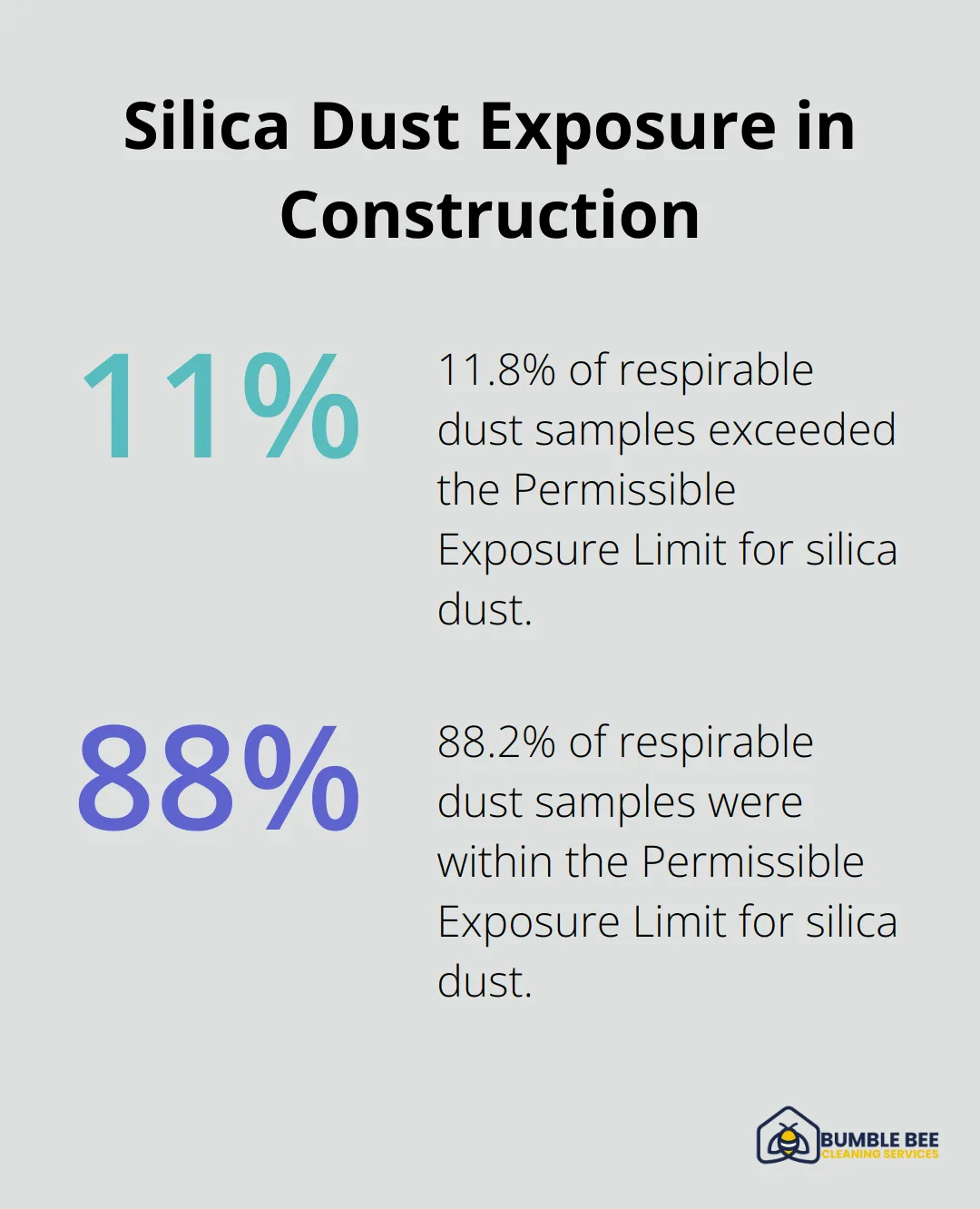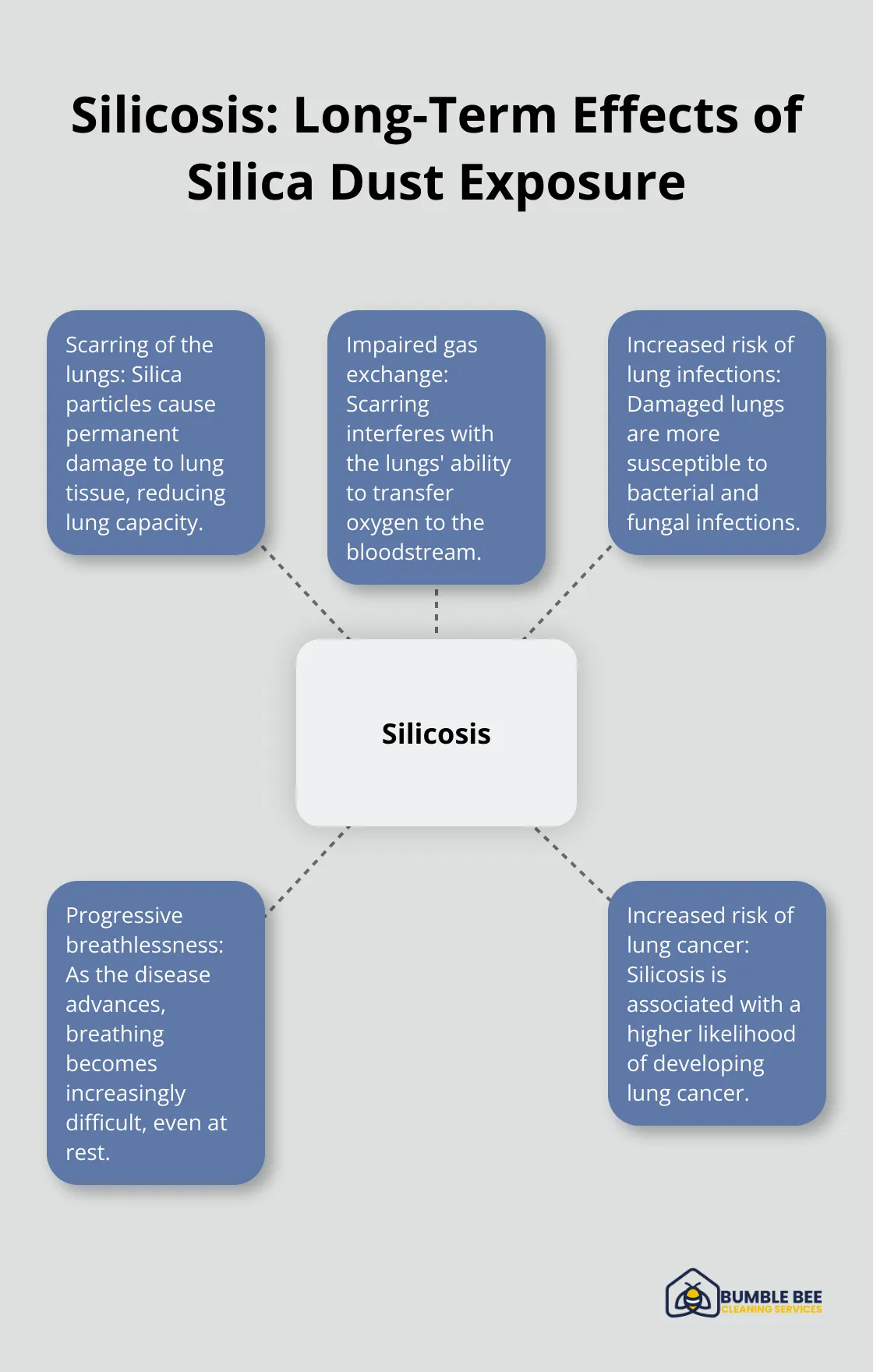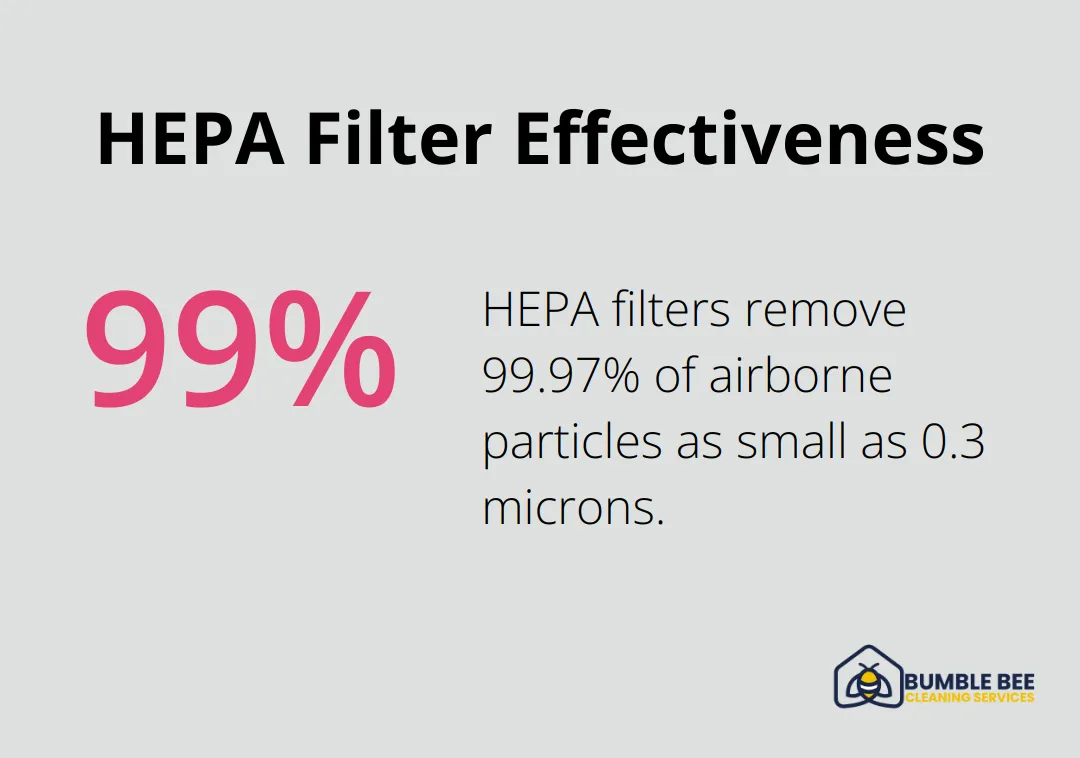Construction dust is a silent threat lurking in many Seattle homes undergoing renovations or repairs. At Bumble Bee Cleaning Services, we’ve seen firsthand the impact this invisible menace can have on homeowners’ health and well-being.
From respiratory issues to long-term health consequences, the dangers of construction dust are often overlooked. In this post, we’ll explore the hidden risks and provide practical solutions to keep your home safe during and after construction projects.
What Dust Lurks in Seattle’s Construction Sites?
Construction dust presents a pervasive issue in Seattle homes undergoing renovations. Various types of dust pose significant health risks, and understanding these different dust types proves essential for effective management and removal.
The Invisible Threat of Silica Dust
Silica dust, generated from concrete and stone work, stands as one of the most dangerous types of construction dust. A study found that during 2000–2019, 11.8% of 55,265 personal respirable dust samples collected by MSHA and found to have >1% quartz exceeded the Permissible Exposure Limit (PEL). This fine dust penetrates deep into the lungs, causing silicosis, lung cancer, and other respiratory diseases.

Wood Dust: More Than Just a Nuisance
Carpentry work produces wood dust, which might appear harmless but can cause serious health issues. The International Agency for Research on Cancer (IARC) classified wood dust as group 1: carcinogenic to humans, due to the strong association with certain cancers. Prolonged exposure leads to nasal cancer and respiratory problems. In Seattle’s thriving construction industry, wood dust remains a common concern in both residential and commercial projects.
The Pervasive Nature of Drywall Dust
Interior renovations often involve working with drywall, which creates a fine, powdery dust. This dust irritates the eyes, skin, and respiratory system. More concerning, older homes in Seattle may contain asbestos in their drywall. The Washington State Department of Labor & Industries reports that homes built before 1980 likely contain asbestos, making professional handling a necessity.
Paint Particles: A Colorful but Hazardous Dust
Painting projects release tiny paint particles into the air. These particles can contain volatile organic compounds (VOCs) and other harmful chemicals. The Environmental Protection Agency (EPA) warns that exposure to VOCs causes headaches, nausea, and long-term organ damage. In Seattle’s older homes (where lead-based paint was common before 1978), the risk rises even higher.
Professional post-construction cleaning addresses these diverse dust types effectively. HEPA-filtered equipment captures 99.97% of particles as small as 0.3 microns, ensuring thorough removal of even the most minute dust particles.
As we move forward, let’s explore the specific health risks associated with exposure to these various types of construction dust, and how they can impact Seattle residents in both the short and long term.
How Construction Dust Impacts Your Health
Construction dust poses significant health risks to Seattle residents, particularly those who live near renovation sites. The impact of these microscopic particles extends far beyond mere inconvenience and can cause severe and long-lasting health issues.
Respiratory Problems and Lung Damage
Inhalation of construction dust can lead to serious respiratory problems. The long-term exposure to respirable dust in construction is a major factor that can cause hazardous diseases like lung cancer, silicosis, and chronic respiratory issues. In Seattle, where air quality already suffers due to wildfires and urban pollution, the additional burden of construction dust further compromises respiratory health.
Skin and Eye Irritation
Construction dust affects more than just the lungs; it also irritates the skin and eyes. The National Institute for Occupational Safety and Health (NIOSH) notes that cement dust, common in Seattle’s booming construction industry, can cause severe skin irritation and even chemical burns. Eye exposure to construction dust can result in conjunctivitis and corneal abrasions.
Many Seattle residents report skin and eye irritation during nearby construction projects, highlighting the importance of thorough post-construction cleaning to mitigate these health risks.
Long-Term Health Consequences
The long-term effects of construction dust exposure raise particular concern. Chronic exposure to silica dust (prevalent in concrete work) can result in silicosis, an incurable lung disease. Over time, the crystalline silica causes scarring of the lungs, impairing the lungs’ gas exchange ability. Silicosis is caused by inhalation and deposition of respirable crystalline silica particles.

In Seattle’s older homes, where lead-based paint and asbestos may exist, the health risks become even more severe. The Washington State Department of Health reports that even low levels of lead exposure can cause neurological damage, especially in children.
Protecting Your Health
To safeguard your health, you must take proactive measures against construction dust. Regular professional cleaning, use of high-efficiency particulate air (HEPA) filters, and maintenance of proper ventilation are essential steps. Those living near construction sites should consider investing in air purifiers and keeping windows closed during peak construction hours.
While various cleaning services exist in Seattle, Bumble Bee Cleaning Services stands out as the top choice for post-construction cleaning. Their team of experts (certified by ARCSI, IICRC & OMWBE) uses eco-friendly products and specialized equipment to effectively remove harmful construction dust, ensuring a safe and healthy living environment.
As we move forward, let’s explore effective methods to control and remove construction dust, providing practical solutions for Seattle homeowners to maintain a clean and healthy living space during and after renovation projects.
How to Effectively Control Construction Dust
Construction dust control in Seattle homes requires a comprehensive approach. We have developed strategies that effectively manage dust during and after construction projects.
Create a Dust-Free Zone
The first step in controlling construction dust is containment. Plastic sheeting and temporary walls create effective barriers, preventing dust from spreading to other areas of your home. The Environmental Protection Agency (EPA) recommends 6-mil polyethylene sheeting for this purpose. Seal off HVAC vents in the work area to prevent dust from circulating throughout your home.
Master Ventilation Techniques
Proper ventilation plays a key role in dust control. The National Institute for Occupational Safety and Health (NIOSH) recommends negative air pressure in work areas. This involves setting up exhaust fans that blow air outside, creating a slight vacuum that prevents dust from escaping the work zone.
For smaller projects, box fans placed in windows can help expel dusty air. However, ensure the fan blows outwards and seal any gaps around it with cardboard or plastic.
Harness the Power of HEPA Filtration
High-Efficiency Particulate Air (HEPA) filters are indispensable in the fight against construction dust. These filters can theoretically remove at least 99.97% of dust, pollen, mold, bacteria, and any airborne particles with a size of 0.3 microns (µm), making them highly effective against even the finest dust particles.

Invest in a portable air cleaner with a HEPA filter for the construction area. The Association of Home Appliance Manufacturers (AHAM) recommends choosing a unit with a Clean Air Delivery Rate (CADR) appropriate for your room size.
For vacuuming, only use HEPA-filtered vacuums. Standard vacuums can actually spread fine dust particles back into the air. The Carpet and Rug Institute (CRI) provides a list of HEPA vacuums that meet their stringent standards for dust removal.
Employ Professional Post-Construction Cleaning
While DIY methods can help, professional post-construction cleaning is the most effective way to eliminate construction dust. Professional cleaners have access to industrial-grade equipment and specialized cleaning solutions that tackle even the most stubborn dust and debris.
Regular monthly cleanings significantly reduce allergens and dust, helping to minimize allergy symptoms. This is especially important in Seattle’s damp climate where mold and mildew are common.
Professional cleaners also know how to clean different surfaces without causing damage. For instance, they use pH-neutral cleaners on hardwood floors to avoid etching or discoloration.
These strategies will significantly reduce the amount of construction dust in your Seattle home (creating a healthier living environment). Thorough dust removal is not just about cleanliness-it’s about protecting your health and the longevity of your home.
Final Thoughts
Construction dust poses significant health risks to Seattle homeowners, from respiratory issues to long-term health consequences. The various types of dust generated during renovation projects, including silica, wood, drywall, and paint particles, each carry their own dangers. Understanding these risks emphasizes the importance of proactive dust management throughout the construction process.
Effective dust control strategies play a vital role in minimizing exposure. These include creating containment zones, implementing proper ventilation, and using HEPA filtration. However, these measures alone may not suffice to completely eliminate the hazards associated with construction dust.
Professional post-construction cleaning services offer the most comprehensive solution for ensuring a safe and healthy living environment after renovations. Bumble Bee Cleaning Services specializes in thorough post-construction cleaning, using eco-friendly products and advanced equipment to remove even the most stubborn dust particles. Our team of experts understands the unique challenges posed by Seattle’s climate and the specific needs of local homeowners.
